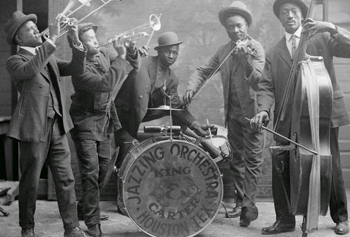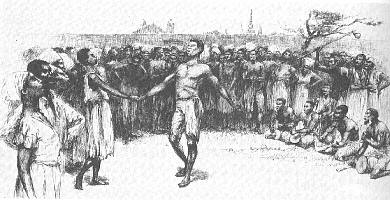
Introduction
With its propulsive and syncopated rhythms, improvisatory melodic freedom, and collaborative creation, jazz is a music that remains difficult to define. When asked to define it, Louis Armstrong's answer was quintessential: "If you have to ask," he said, "you'll never know." Originally a musical expression of African American musicians in and around New Orleans at the end of the nineteenth century, jazz has now transcended racial, ethnic and geographical boundaries.
Like the diversity that characterizes America, jazz too blends elements of African, Caribbean, and western European culture and is a democratic music where the individual expression of its creator is a treasured attribute.
Jazz is deeply rooted in an oral tradition, and this is one reason why its earliest years are shrouded in controversy. The vibrant immediacy of jazz is difficult to capture in music notation making jazz more ephemeral than many other kinds of western music. On the other hand, jazz is a music that has the advantage of coinciding with the advent of recording technology that is often used to preserve its rich legacies.
Two of the most essential aspects of jazz are syncopation and improvisation. Syncopation is the effect of displacing the emphasis so that the strong beats are undermined and the weaker beats strengthened. Since much of the music we listen to in western culture strongly emphasizes the metrical placement of the beat (or pulse), the frequent use of syncopation is an aspect that instantly identifies the jazz sound.
Improvisation is the ability to compose and perform instantaneously, essentially "making up" music on the spot. When a vocalist creates an improvisation, it is called scat singing. In scat singing, singers use nonsense words or syllables that can often sound like musical instruments.
One of the most common structural forms in jazz is that the improvised section comes in between two statements of the main tune. The tune, or head as it is usually called in jazz, is a generally straightforward performance of the composed music.
When the improvisation takes place, the basic elements of the head continue (a sequence of chord progressions, bass lines, etc.) but now the melodic line is replaced with an improvised one. This section is often of indeterminate length but generally lasts as long as it takes for each musician to make an improvisation over one pass of the composed tune.
Listen to this excerpt from a jazz performance, and while listening, try to identify elements that help these two superb musicians, vocalist and bassist, create a rich dialogue between them. ("Do Nothing Till You Hear From Me," music by Duke Ellington, lyrics by Bob Russell. Performed by Ella Fitzgerald, voice.)
♫ ![]() Do Nothing Till You Hear From Me
Do Nothing Till You Hear From Me
Ella Fitzgerald
Probably the most noticeable aspect of this performance is its rhythmic sensibility. Even without a drum set, the music has a very strong sense of beat, but it seems to float above that beat. This special quality is called "swing." It is nearly impossible to describe swing with specificity. "Swing" might be best understood as a feeling and it is often a trait that distinguishes performer from performer.
The upright bass playing pizzicato (plucking the strings rather than bowing them as in classical music) is commonly heard in jazz. This is called a "walking" bass. "Walking" occurs when a bass plays equal note values (usually quarter notes) on every beat in an unsyncopated manner.





"Duke Ellington wrote over 1,000 compositions in his lifetime as a Jazz band-leader, composer and pianist, including Jazz standards, film scores and classical works."







